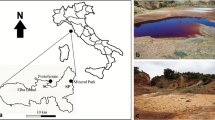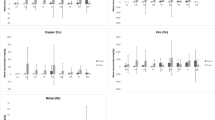Abstract
Industrial revolution markedly increased the environmental contamination by different pollutants, which include the metal lead (Pb). The phytoremediation potential of native species from tropical regions is little known, especially for woody plants. The present study aimed to evaluate the performance of Lonchocarpus cultratus (Fabaceae), a tree species from the Brazilian savanna, grown in soil that was artificially contaminated with increasing Pb concentrations (control and 4 Pb treatments, 56, 120, 180, and 292 mg kg−1) for 6 months. The biomass of L. cultratus was not depressed by exposure to Pb, despite the high accumulation of this metal (up to 7421.23 μg plant−1), indicating a high plant tolerance to this trace metal. Lead was mainly accumulated in roots (from 67 to 99%), suggesting that the low root-to-shoot Pb translocation is a plant strategy to avoid Pb-induced damages in photosynthetic tissues. Accordingly, the content of chlorophylls a and b was maintained at similar levels between Pb-treated and control plants. Moreover, increments in leaf area were noticed in Pb-treated plants in comparison to the control plants (on average, 24.7%). In addition, root length was boosted in plants under Pb exposure (22.6–66.7%). In conclusion, L. cultratus is able to endure the exposure to high Pb concentrations in soil, being a potential plant species to be used for Pb phytostabilization in metal-contaminated soils in tropical regions.




Similar content being viewed by others
Data availability
Not applicable.
References
Agathokleous E, Kitao M, Calabrese EJ (2020) Hormesis: highly generalizable and beyond laboratory. Trends Plant Sci 25:1076–1086
Ali H, Khan E, Sajad MA (2013) Phytoremediation of heavy metals – concepts and applications. Chemosphere 91:869–881
Brasil (2015) Mapeamento do uso e cobertura do cerrado: Projeto TerraClass Cerrado. Ministério do Meio Ambiente, Brasília, DF
Buch AC, Sautter KD, Marques ED, Silva-Filho EV (2020) Ecotoxicological assessment after the world’s largest tailing dam collapse (Fundão dam, Mariana, Brazil): effects on oribatid mites. Environ Geochem Health 42:3575–3595
Carvalho MEA, Piotto FA, Franco MR, Rossi ML, Martinelli AP, Cuypers A, Azevedo RA (2019) Relationship between Mg, B and Mn status and tomato tolerance against Cd toxicity. J Environ Manag 240:84–92
Carvalho MEA, Castro PRC, Kozak M, Azevedo RA (2020a) The sweet side of misbalanced nutrients in cadmium-stressed plants. Ann Appl Biol 176:275–284
Carvalho MEA, Castro PRC, Azevedo RA (2020b) Hormesis in plants under Cd exposure: from toxic to beneficial element? J Hazard Mater 384:121434
Carvalho MEA, Gaziola SA, Carvalho LA, Azevedo RA (2021) Cadmium effects on plant reproductive organs: physiological, productive, evolutionary and ecological aspects. Ann Appl Biol 178:227–243
CETESB – Companhia Ambiental do Estado de São Paulo (2016) Valores orientados para solos e águas subterrâneas no estado de São Paulo (Decisão de Diretoria n° 256/2016/e, de 22 de novembro de 2016). Available at: https://cetesb.sp.gov.br/aguas-subterraneas/wp-content/uploads/sites/13/2013/11/dd256_2016_e_valoresorientadoresdioxinasefuranos2016.pdf. Accessed 18 Apr 2021
Chudzik B, Szczuka E, Leszczuk A, Strubińska J (2018) Modification of pectin distribution in sunflower (Helianthus annuus L.) roots in response to lead exposure. Environ Exp Bot 155:251–259
Core Team R (2019) R: A language and environment for statistical computing. R Foundation for Statistical Computing, Vienna, Austria Available at: https://www.R-project.org/
Dias MC, Mariz-Ponte N, Santos C (2019) Lead induces oxidative stress in Pisum sativum plants and changes the levels of phytohormones with antioxidant role. Plant Physiol Biochem 137:121–129
EPA – United States Environmental Protection Agency (2007) Method 3051A (SW-846): Microwave assisted acid digestion of sediments, sludges, and oils. Revision 1
Gomes ACS, Lindino CA, Gonçalves Jr AC, Gomes GD (2013) Determination of Cd, Cr and Pb in milk and in cattle feed in Brazil. Rev Inst Adolfo Lutz 72:211–218
Gonçalves JAC, Luchese EB, Lenzi E (2000) Avaliação da fitodisponibilidade de cádmio, chumbo e cromo, em soja cultivada em Latossolo Vermelho Escuro tratado com fertilizantes comerciais. Quím Nova 23:173–177
Gonçalves RM, Gonçalves JR, Gonçalves RM, Oliveira RR, Oliveira RA, Lage ME (2009) Physical-chemical evaluation of and heavy metals contents in broiler and beef mechanically deboned meat (MDM) produced in the state of Goiás, Brazil. Ciê Anim Brasi 10:553–559
Gonçalves JR, Gonçalves RM, Gonçalves RM (2010a) Cádmio, chumbo e solubilidade do fósforo em suplementos minerais bovinos comercializados em Goiás. Rev Proc Quím 4:68–77
Gonçalves RM, Gonçalves JR, Fornés NS (2010b) Cadmium in human milk: concentration and relation with the lifestyle of women in the puerperium period. Rev Bras Ginecol Obstet 32:340–345
Ilić ZH, Pajević S, Borišev M, Luković J (2020) Assessment of phytostabilization potential of two Salix L. clones based on the effects of heavy metals on the root anatomical traits. Environ Sci Pollut Res 27:29361–29383
Kabata-Pendias A (2011) Trace elements in soils and plants, 4th edn. CRC Press, Boca Raton
Lebrun M, Miard F, Nandillon R, Léger JC, Hattab-Hambli N, Scippa GS, Bourgerie S, Morabito D (2018) Assisted phytostabilization of a multicontaminated mine technosol using biochar amendment: early stage evaluation of biochar feedstock and particle size effects on as and Pb accumulation of two Salicaceae species (Salix viminalis and Populus euramericana). Chemosphere 194:316–326
Lima LR, Silva HF, Brignoni AS, Silva FG, Camargos LS, Souza LA (2019) Characterization of biomass sorghum for copper phytoremediation: photosynthetic response and possibility as a bioenergy feedstock from contaminated land. Physiol Mol Biol Plants 25:433–441
Longo RM, Ferreira DHL, Silva AL, Penereiro JC, Mendes DR (2020) Chemical attributes and heavy metals in soils of urban forest remainings. Rev Cerrados 18:183–207
Mallhi ZM, Rizwan M, Mansha A, Ali Q, Asim S, Ali S, Hussain A, Alrokayan SH, Khan HA, Alam P, Ahmad P (2019) Citric acid enhances plant growth, photosynthesis, and phytoextraction of lead by alleviating the oxidative stress in castor beans. Plants 8:525
Marcílio T, Barbeiro C, Firmino TP, Romagnolo MB, Souza LA, Pastorini LP (2019) Flooding and submersion-induced morphological and physiological adaptive strategies in Lonchocarpus cultratus. Aquat Bot 159:103–146
Medeiros JD (2011) Guia de campo: vegetação do Cerrado 500 espécies. MMA/SBF, Brasília
Mendonça RC, Felfili JM, Walter BMT, Silva MCJ, Rezende AV, Filgueiras TS (1998) Flora vascular do bioma Cerrado. In: Sano SM, Almeida SP, Ribeiro JF (eds) Cerrado: ecologia e flora. Brasília, Embrapa Informação Tecnológica, pp 421–1279
Mingoti R, Spadotto CA, Moraes DAC (2016) Suscetibilidade à contaminação da água subterrânea em função de propriedades dos solos no Cerrado brasileiro. Pesq Agropec Brasil 51:1252–1260
Miranda HLM (2016) Elementos-traço em solos agrícolas de Rio Verde- Goiás. Thesis presented for obtaining the Master in Agroquímica. Instituto Federal de Educação, Ciência e Tecnologia Goiano, Campus Rio Verde
Muszyńska E, Labudda M, Kral A (2020) Ecotype-specific pathways of reactive oxygen species deactivation in facultative metallophyte Silene vulgaris (Moench) Garcke treated with heavy metals. Antioxidants 9:102
Nogueira TAR, Sampaio RA, Fonseca IM, Ferreira CS, Santos SE, Ferreira LC, Gomes E, Fernandes LA (2007) Metais pesados e patógenos em milho e feijão caupi consorciados, adubados com lodo de esgoto. Rev Brasil Eng Agr Amb 11:331–338
Panarari RS, Prioli AJ, Prioli SMAP, Souza MC, Oliveira AV, Boni TA, Lucio LC, Prioli LM (2004) Molecular polymorphism in Lonchocarpus cultratus (Fabaceae) from riparian areas of natural reforesting in Upper Paraná River, Brazil. Acta Sci Biol Sci 26:335–341
Ribeiro BT, Nascimento DC, Curi N, Guilherme LRG, Costa ETS, Lopes G, Carneiro JP (2019) Assessment of trace element contents in soils and water from cerrado wetlands, triângulo mineiro region. Rev Bras Cienc Solo 43:e0180059
Samuilov S, Lang F, Djukic M, Djunisijevic-Bojovic D, Rennenberg H (2016) Lead uptake increases drought tolerance of wild type and transgenic poplar (Populus tremula x P. alba) overexpressing gsh 1. Environ Pollut 216:773–785
SAS Institute (2011) SAS/STAT User’s Guide: Version 93 SAS Institute, Cary
Shi W-G, Liu W, Yu W, Zhang Y, Ding S, Li H, Mrak T, Kraigher H, Luo Z-B (2019) Abscisic acid enhances lead translocation from the roots to the leaves and alleviates its toxicity in Populus × canescens. J Hazard Mater 362:275–285
Soares AP, Weber OLS, Santo OE (2015) Metais pesados em calcários do estado de Mato Grosso. Geociências 34:465–474
Soares C, Carvalho MEA, Azevedo RA, Fidalgo F (2019) Plants facing oxidative challenges - a little help from the antioxidant networks. Environ Exp Bot 161:4–25
Souza SCR, Andrade SAL, Souza LA, Schiavinato MA (2012) Lead tolerance and phytoremediation potential of Brazilian leguminous tree species at the seedling stage. J Environ Manag 110:299–307
Souza SCR, Souza LA, Schiavinato MA, Silva FMO, Andrade SAL (2020) Zinc toxicity in seedlings of three trees from the Fabaceae associated with arbuscular mycorrhizal fungi. Ecotoxicol Environ Saf 195:110450–110458
Science Communication Unit (2013) Science for environment policy in-depth report: soil contamination: impacts on human health. Report produced for the European Commission DG Environment. Available at: http://ec.europa.eu/science-environment-policy
Vaissie P, Monge A, Husson F (2020) Factoshiny: perform factorial analysis from 'FactoMineR' with a shiny application. R package version 2:2
Vergilio CS, Lacerda D, Oliveira BCV, Sartori E, Campos GM, ALS P, Aguiar DB, Souza TS, Almeida MG, Thompson F, Rezende CE (2020) Metal concentrations and biological effects from one of the largest mining disasters in the world (Brumadinho, Minas Gerais, Brazil). Sci Rep 10:5936
Verma S, Dubey RS (2003) Lead toxicity induces lipid peroxidation and alters the activities of antioxidant enzymes in growing rice plants. Plant Sci 164:645–655
Wang CR, Tian Y, Wang XR, Yu HX, Lu XW, Wang C, Wang H (2010) Hormesis effects and implicative application in assessment of lead-contaminated soils in roots of Vicia faba seedlings. Chemosphere 80:965–971
Acknowledgements
We are grateful to Fundação de Amparo à Pesquisa de Goiás – FAPEG (Grant: Call 03/2017) for the scholarship to D.G.O., to Fundação de Amparo à Pesquisa do Estado de São Paulo – FAPESP (Grants: 2015/09567-9 and 2018/01498-6) for the scholarship to L.S.C., and to Conselho Nacional de Desenvolvimento Científico e Tecnológico – CNPq (Grant: 155926/2018-7) for the scholarship to M.E.A.C. We also thank Dr. Alan C. Costa and Dr. Roberto G. Vital for the support with IRGA.
Funding
The financial support was provided by the Fundação de Amparo à Pesquisa de Goiás – FAPEG (Grant: Call 03/2017), Fundação de Amparo à Pesquisa do Estado de São Paulo – FAPESP (Grants: 2015/09567-9; 2018/01498-6), and Conselho Nacional de Desenvolvimento Científico e Tecnológico – CNPq (Grant: 155926/2018-7).
Author information
Authors and Affiliations
Contributions
1. Lucas Anjos Souza (corresponding author): Conceptualization, methodology, formal analysis, writing - review and editing, supervision, project administration, funding acquisition
2. Dayane G. Oliveira (first author): Investigation, formal analysis, writing – first draft
3. Marcia E. A. Carvalho: Formal analysis, writing - original draft, visualization, writing - review and editing
4. Higor F. Silva: Investigation
5. Letícia R. Lima: Investigation
6. Alcindo Sousa Brignoni: Investigation
7. Liliane Santos Camargos: Conceptualization, formal analysis, writing - review and editing, funding acquisition
Corresponding author
Ethics declarations
Ethical approval and consent to participate
Not applicable.
Consent to publish
Not applicable.
Conflict of interest
The authors declare no competing interests.
Additional information
Responsible Editor: Gangrong Shi
Publisher’s note
Springer Nature remains neutral with regard to jurisdictional claims in published maps and institutional affiliations.
Rights and permissions
About this article
Cite this article
Oliveira, .G., Carvalho, M.E.A., Silva, H.F. et al. Lonchocarpus cultratus, a Brazilian savanna tree, endures high soil Pb levels. Environ Sci Pollut Res 28, 50931–50940 (2021). https://doi.org/10.1007/s11356-021-15856-5
Received:
Accepted:
Published:
Issue Date:
DOI: https://doi.org/10.1007/s11356-021-15856-5




